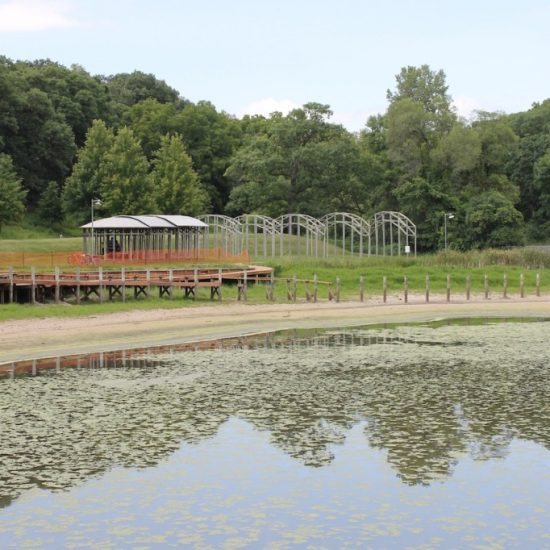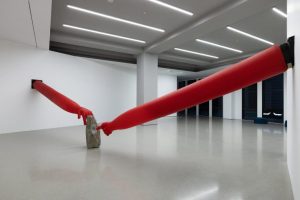The artist Mary Miss has filed a lawsuit in federal court to prevent the demolition of her outdoor installation at the Des Moines Art Center (DMAC), which the museum commissioned, but now claims is unsalvageable after years of decay.
The suit was filed today in US District Court for the Southern District of Iowa’s Central Division with Miss seeking a temporary restraining order against the museum, halting the demolition of her 1996 installation Greenwood Pond: Double Site until the matter can be resolved in court. The suit has called for DMAC to honor its 1994 contract with Miss, and accuses the institution of violating the Visual Artists Rights Act (VARA) of 1990 through the “destruction of a work of recognized stature, and any intentional or grossly negligent destruction of that work.” Miss is also seeking monetary damages, according to her legal representation, the Des Moines–based firm Wandro, Kanne & Lalor. (Miss is also represented by Dave Bright with the Iowa Volunteer Lawyers for the Arts.)
Related Articles
In January, Washington, D.C.–based arts advocacy group the Cultural Landscape Foundation (CLF) revealed DMAC’s planned demolition of Greenwood Pond, propelling it to the center of debates over the responsibilities museums bear for works they commissioned.
Mary Miss, 79, is a leading figure of the Land art movement and one of the movement’s few women artists. The contested installation was built in dialogue with the wetland ecosystem of Greenwood park, which abuts DMAC. A series of walkable structures variably made of wood, cement, steel, and granite surround and intersect the lagoon, offering visitors an intimate degree of access to its wildlife; Miss described her work as “an outdoor classroom.”
In a letter dated January 17, addressed to Miss and reviewed by ARTnews, the museum’s board shared its plans to deaccession the 30-year-old installation, saying that its materials had eroded, and reengineering it was “not financially feasible.” The museum soon faced criticism from artists, curators, and cultural workers over its decision.
In more than 40 letters, addressed to the museum’s director Kelly Baum and published by CLF, detractors—including the museum’s former deputy director Jessica Row, arts philanthropist Emily Rauh Pulitzer, critic and art historian Lucy R. Lippard—questioned the museum’s efforts to raise enough funding to salvage the installation, and lament its removal as a loss to the canon of environmental art.
In a letter dated January 31, Rowe, who served as deputy director of the Des Moines institution from 1987 to 2004, called Greenwood Pond a “living masterpiece” that “revitalized” a neglected part of the DMAC’s campus.
Throughout the 1990s, the DMAC commissioned Miss, as well as artists like Richard Serra and Bruce Nauman, to create outdoor artworks for its campus. While the wood in Miss’s work has degraded due to weather, the contributions from Serra and Nauman, consisting of industrial materials, remain relatively well preserved.
Extensive repairs on Greenwood Pond were completed in 2014, a process that extended its lifecycle for nearly a decade, but they proved to be only a temporary fix. In January, the museum’s board sent Miss a letter informing her of its decision to destroy the work. The letter also cited Miss’ previous acknowledgment that Greenwood Pond may potentially need to be de-installed by 2012.
In February, Baum told ARTnews that the cost of repairing the work and its continued maintenance was about $8 million. To raise that amount, she said, the museum would need to establish an endowment for its indefinite maintenance, as well as create three new positions—a registrar, a curator, and a facilities associate—to oversee the fundraising campaign.
“That investment is not forthcoming. It would require reorienting our entire mission toward the care of a single work of art,” Baum said. The museum’s operating budget in 2023 was $7.7 million.
The CLF, however, has pointed out that works created by Miss in the 1980s and constructed from similar materials as Greenwood Pond have been well maintained elsewhere. One of them, South Cove in Battery Park City, the CLF added, survived 9/11 and Hurricane Sandy.
“The Art Center Board and Director’s lack of consultation, disregard of their contractual obligations, and shameful treatment of the artwork have forced this issue into the courts,” Miss said in a statement. “They have only themselves to blame for this avoidable scandal.”
ARTnews has contacted the Des Moines Art Center for comment.




